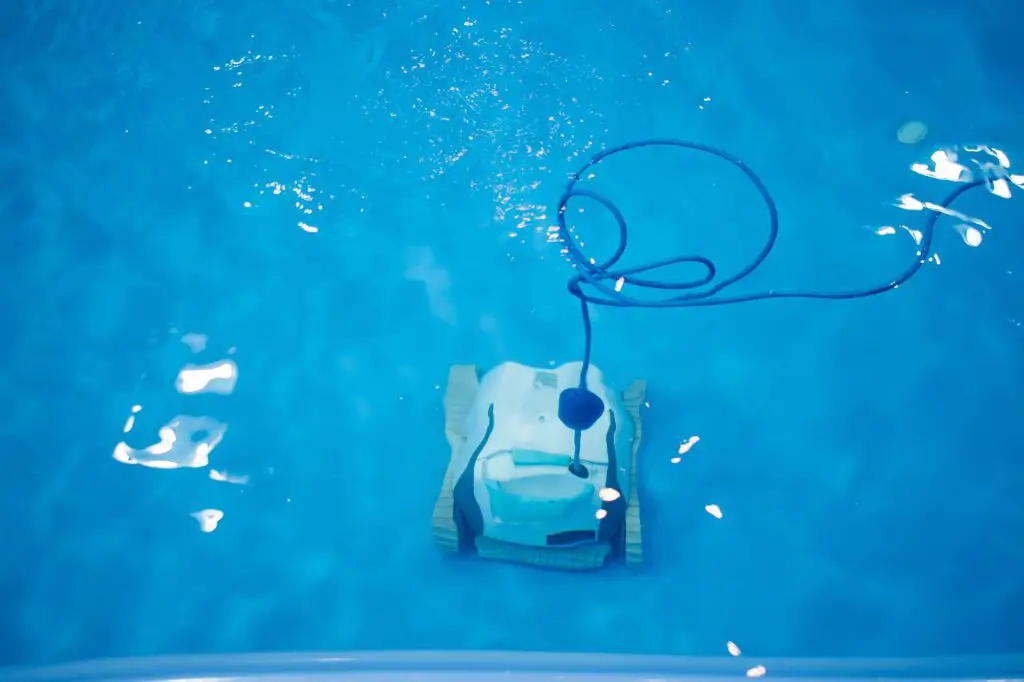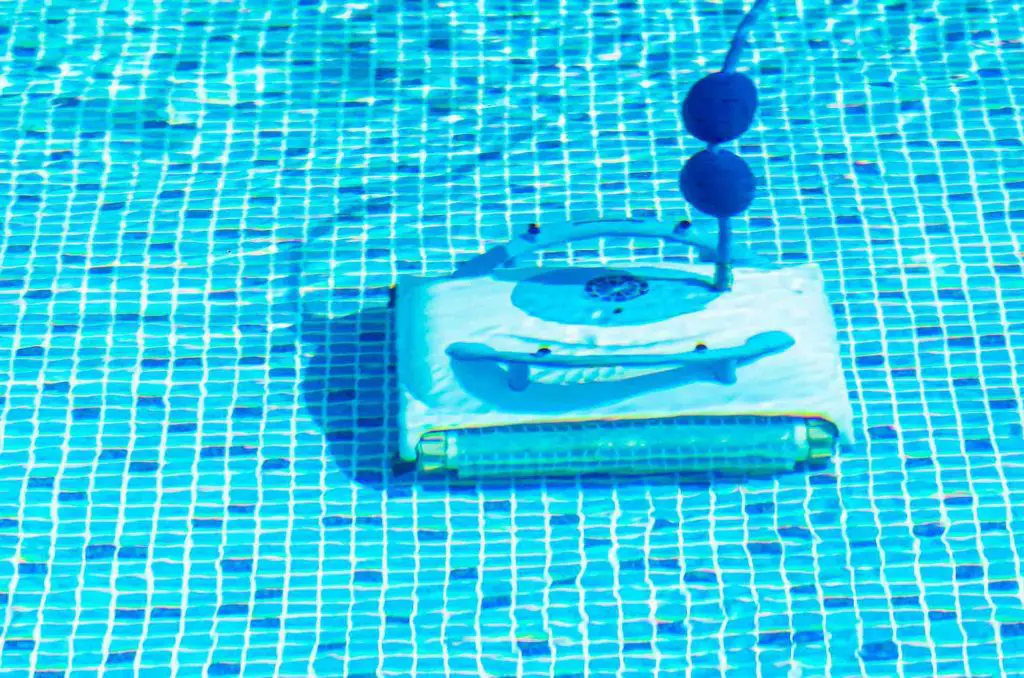Robot pool cleaners are a convenient way to keep your pool clean and safe from debris that can clog the pool’s filtration system. When the robot pool cleaner isn’t working efficiently (like when it doesn’t clean the shallow end), it’s a cause for concern.
Your robot pool cleaner will not clean the shallow end possibly due to a short power cord, power supply issues, or algae overgrowth in the pool. Your machine may also have wear and tear issues. A full canister that has gotten too heavy is another common cause.
Continue reading to learn more about why your robot pool cleaner won’t clean the shallow end. I’ll also look into practical solutions for each specific issue.

1. The Power Cord Is Too Short
Your robot cleaner’s power cord tends to twist and coil around itself or on handrails and ladders as it moves around to clean. This tangling shortens the cord’s length, making it impossible for the robot pool cleaner to reach the shallow end.
Also, the machine’s power cord may be too short relative to the size of your pool. In this case, parts of the pool (such as the shallow end) may not be cleaned thoroughly, if at all.
How To Fix
The moment you realize that your robot pool cleaner’s power cord is tangled, manually straighten it out. It’s best to switch off the power supply first before you detangle. Straightening the cord after each cleaning will also help prevent tangling.
To solve the problem of a short cord, buy a compatible extended power cord from the manufacturer.
2. Power Supply Issues
Robot pool cleaners rely on an external power supply to function. An interrupted power supply keeps the electric motor from creating suction, which it needs to clean your pool.
Possible causes of robot pool cleaner power supply issues are:
- The machine hasn’t been plugged in.
- No power is available at the outlet.
- There’s damage to the power cord (which may cause a short circuit).
How To Fix
Check that your robot pool cleaner is plugged into a working power source. The indicator light should be on if the machine is getting enough power. If you’re not sure where the indicator light is or what it should look like when it’s working, check the manual that came with your cleaner.
If the power supply isn’t the issue, inspect the power cord for any signs of damage. This guide can help you check for not-so-obvious signs of damaged power cords. If the power cord is the issue, buy a replacement cord from the manufacturer. That way, you can be sure that it’s compatible with your cleaner.
3. There Is Algae Overgrowth
Swimming pool algae isn’t only a health hazard: It also gets in the way of your robot pool cleaner. Left unattended, the algae creates a slimy layer on the pool floor, making your robot cleaner slide back as it tries to move toward the shallow end.
Also, algae can clog up your robot pool cleaner, causing it to become inefficient or unable to move.
Algae growth may also prevent your robot cleaner from climbing the pool’s walls.
How To Fix
Algae growth in your pool is a serious concern, so you must take care of it as soon as possible.
Here are a few suggestions for cleaning algae from your swimming pool:
- Apply algaecides.
- Balance your pool water’s pH since algae thrive in alkaline conditions. You can test your pool’s pH with the Taylor Swimming Pool Test Kit
- Filter the pool water.
- Consider home remedies.
If you’re thinking of cleaning an algae-infested pool with a robot pool cleaner, think again. Algae spores can stay in the machine and get reintroduced into the pool during subsequent pool cleanings. Therefore, don’t clean algae with a robot pool cleaner under any circumstances.

4. Wear and Tear to the Robot Pool Cleaner
Certain parts of your robot pool cleaner may have begun to undergo wear and tear, reducing its ability to clean all parts of the pool effectively.
How To Fix
First, inspect the following parts of your robot pool cleaner:
- Electric motor: This part creates the suction force that sucks up dirt and debris in the pool.
- Belts and wheels: These parts facilitate the movement of the machine through the pool. The belts may have loosened or detached from the wheel or track.
- Water pump: The water pump propels the robot pool cleaner through the pool and filters the water.
The machine’s user manual should help you identify any parts you have trouble locating.
That said, it’s best to have the robot pool cleaner inspected and repaired by a qualified professional.
If you want to perform your own repairs, consult the manufacturer for advice on how to install your specific brand’s replacement parts. Make sure you do this carefully, however, as any accidental damage from DIY repairs can void existing warranties on your machine.
To make sure your robot cleaner stays in good condition, proper use and maintenance are essential.
5. The Canister Is Weighing Down Your Robot Pool Cleaner
All the filtered dirt and debris that goes through the robot vacuum cleaner is stored in its canister. When this canister fills up to a certain level, it can weigh down your robotic pool cleaner, limiting its ability to climb the slope to the pool’s shallow end.
Luckily, this issue doesn’t require professional expertise to resolve.
How To Fix
Clean out your robot pool cleaner’s canister regularly to prevent build-up that can weigh it down. Some machines have dirty canister indicators, so refer to your brand’s specifications guide to check whether yours has one.
This Youtube video will guide you on how to clean your robot pool cleaner’s canister after use:
Summary
When your robot pool cleaner doesn’t clean the shallow end, the solution can be as simple as checking whether it’s plugged in and has a working power supply. On the other hand, the issue may be serious enough to warrant the assistance of a professional, such as damaged parts.
Remember that proper use and maintenance of your robot pool cleaner will get you more bang for your buck, as you can reduce avoidable repairs and get the most out of your machine.
Sources
- Science Online: Robotic Pool Cleaners (RPC): review, uses, advantages, and disadvantages
- Mr. Pool Man: Pool Cleaner Troubleshooting (Our DIY How To Guide)
- Mr. Pool Man: Pros and Cons of a Robotic Pool Cleaner
- Pool Assist: Troubleshooting a Robotic Pool Cleaner
- Robotic Pool Cleaner Organization: Algae in Swimming Pools: How to Get Rid of it Fast and Forever!
- Robots in My Home: Troubleshooting Your Robotic Pool Cleaner: Solutions to Common Problems
- Flower Mound Pool Service: Why is my Robot Pool Cleaner not Moving? Pool Cleaner Problem Solving
- Pool Research: How Automatic Pool Cleaners Work: Breaking It Down
- Cables: Identifying the Risk of Damaged Cords: When to Replace Your Power Cord
- The Pool Butler: What Causes Swimming Pool Algae?
- Den Garden: How to Get Rid of Algae in a Pool Without Chemicals Naturally
